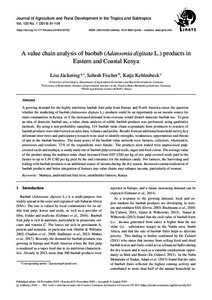Aufsatz

A value chain analysis of baobab (Adansonia digitata L.) products in Eastern and Coastal Kenya
Zusammenfassung
A growing demand for the highly nutritious baobab fruit pulp from Europe and North America raises the question whether the marketing of baobab (Adansonia digitata L.) products could be an opportunity as an income source for rural communities in Kenya, or if the increased demand from overseas would disturb domestic baobab use. To gain an idea of domestic baobab use, a value chain analysis of edible baobab products was performed, using qualitative methods. By using a non-probability sampling, 134 baobab value chain respondents from producers to retailers of baobab products were interviewed on sales data, volumes and profits. Results from an additional household survey, key informant interviews and participatory research were used to identify strengths, weaknesses, opportunities and threats of and to the baobab business.
The main actors of the baobab value network were farmers, collectors, wholesalers, processors and retailers; 72% of the respondents were female. The products most traded were unprocessed pulp-covered seeds and mabuyu, a candy made out of baobab pulp-covered seeds, sugar and food colour. The average value of the product along the mabuyu value chain increased from 0.07 USD per kg of raw pulp-covered seeds paid to the farmer to up to 1.50 USD per kg paid by the end consumer for the mabuyu candy. For farmers, the harvesting and trading with baobab products is an additional source of income during the dry season.
Increased commercialisation of baobab products and better integration of farmers into value chains may enhance income, particularly of women.
The main actors of the baobab value network were farmers, collectors, wholesalers, processors and retailers; 72% of the respondents were female. The products most traded were unprocessed pulp-covered seeds and mabuyu, a candy made out of baobab pulp-covered seeds, sugar and food colour. The average value of the product along the mabuyu value chain increased from 0.07 USD per kg of raw pulp-covered seeds paid to the farmer to up to 1.50 USD per kg paid by the end consumer for the mabuyu candy. For farmers, the harvesting and trading with baobab products is an additional source of income during the dry season.
Increased commercialisation of baobab products and better integration of farmers into value chains may enhance income, particularly of women.
Zitierform
In: Journal of Agriculture and Rural Development in the Tropics and Subtropics (JARTS) Vol. 120 / No. 1 (2019-11-14) , S. 91-104 ; ISSN 2363-6033Zusätzliche Informationen
Gedruckte Ausg. im Verlag Kassel Univ. Press (www.upress.uni-kassel.de) erschienen.Sammlung(en)
Vol 120, No 1 (2019) (Journal of Agriculture and Rural Development in the Tropics and Subtropics (JARTS))Zitieren
@article{doi:10.17170/kobra-20191030732,
author={Jäckering, Lisa and Fischer, Sahrah and Kehlenbeck, Katja},
title={A value chain analysis of baobab (Adansonia digitata L.) products in Eastern and Coastal Kenya},
journal={Journal of Agriculture and Rural Development in the Tropics and Subtropics (JARTS)},
year={2019}
}
0500 Oax 0501 Text $btxt$2rdacontent 0502 Computermedien $bc$2rdacarrier 1100 2019$n2019 1500 1/eng 2050 ##0##http://hdl.handle.net/123456789/11357 3000 Jäckering, Lisa 3010 Fischer, Sahrah 3010 Kehlenbeck, Katja 4000 A value chain analysis of baobab (Adansonia digitata L.) products in Eastern and Coastal Kenya / Jäckering, Lisa 4030 4060 Online-Ressource 4085 ##0##=u http://nbn-resolving.de/http://hdl.handle.net/123456789/11357=x R 4204 \$dAufsatz 4170 7136 ##0##http://hdl.handle.net/123456789/11357
<resource xsi:schemaLocation="http://datacite.org/schema/kernel-2.2 http://schema.datacite.org/meta/kernel-2.2/metadata.xsd"> 2019-11-19T13:35:53Z 2019-11-19T13:35:53Z 2019-11-14 doi:10.17170/kobra-20191030732 http://hdl.handle.net/123456789/11357 Gedruckte Ausg. im Verlag Kassel Univ. Press (www.upress.uni-kassel.de) erschienen. eng Urheberrechtlich geschützt https://rightsstatements.org/page/InC/1.0/ Mabuyu underutilised fruit trees smallholder farmers Kenya 630 A value chain analysis of baobab (Adansonia digitata L.) products in Eastern and Coastal Kenya Aufsatz A growing demand for the highly nutritious baobab fruit pulp from Europe and North America raises the question whether the marketing of baobab (Adansonia digitata L.) products could be an opportunity as an income source for rural communities in Kenya, or if the increased demand from overseas would disturb domestic baobab use. To gain an idea of domestic baobab use, a value chain analysis of edible baobab products was performed, using qualitative methods. By using a non-probability sampling, 134 baobab value chain respondents from producers to retailers of baobab products were interviewed on sales data, volumes and profits. Results from an additional household survey, key informant interviews and participatory research were used to identify strengths, weaknesses, opportunities and threats of and to the baobab business. The main actors of the baobab value network were farmers, collectors, wholesalers, processors and retailers; 72% of the respondents were female. The products most traded were unprocessed pulp-covered seeds and mabuyu, a candy made out of baobab pulp-covered seeds, sugar and food colour. The average value of the product along the mabuyu value chain increased from 0.07 USD per kg of raw pulp-covered seeds paid to the farmer to up to 1.50 USD per kg paid by the end consumer for the mabuyu candy. For farmers, the harvesting and trading with baobab products is an additional source of income during the dry season. Increased commercialisation of baobab products and better integration of farmers into value chains may enhance income, particularly of women. open access Jäckering, Lisa Fischer, Sahrah Kehlenbeck, Katja publishedVersion ISSN 2363-6033 No. 1 Journal of Agriculture and Rural Development in the Tropics and Subtropics (JARTS) 91-104 Vol. 120 </resource>
Die folgenden Lizenzbestimmungen sind mit dieser Ressource verbunden:
Urheberrechtlich geschützt

